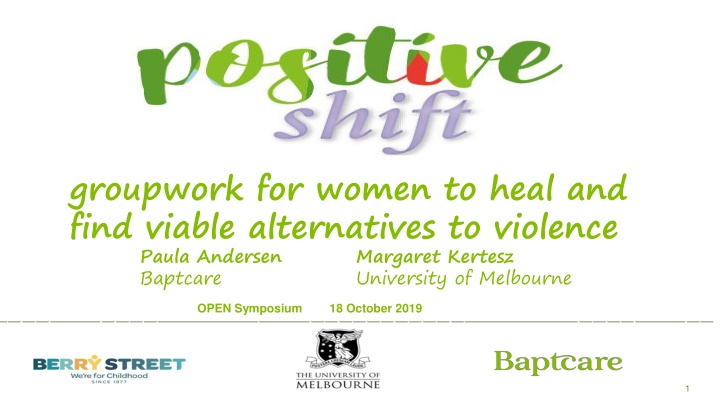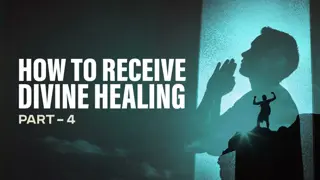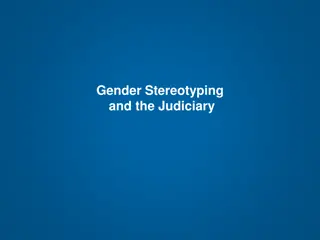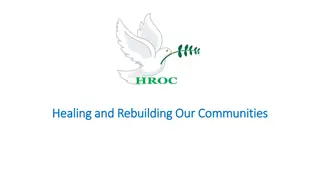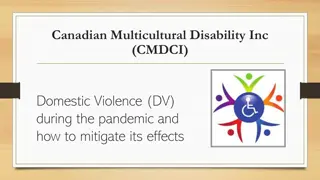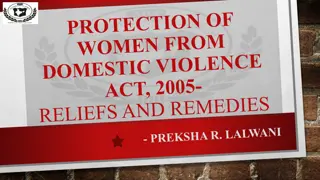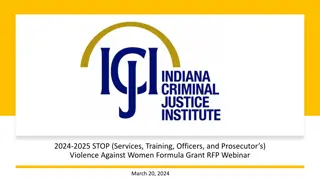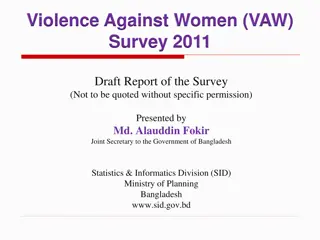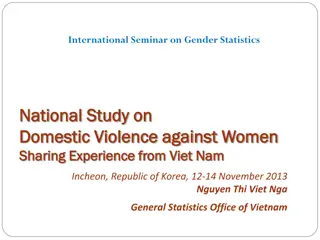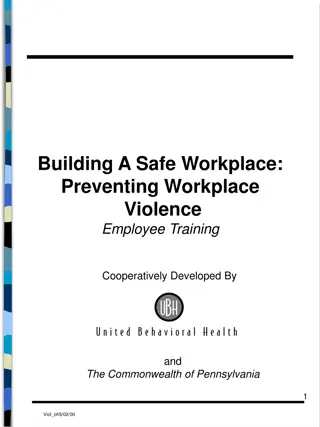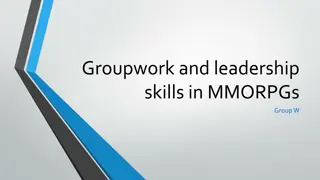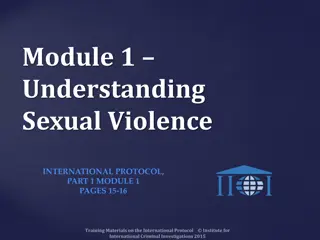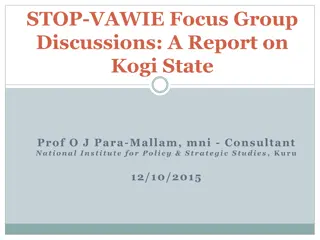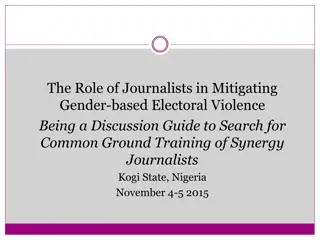Groupwork for Women: Healing and Alternatives to Violence
Explore a program focusing on groupwork for women to heal from trauma, address intersectional identities, and find viable alternatives to violence. With a gender-responsive and trauma-informed approach, this initiative aims to promote healing, enhance protection strategies, and facilitate engagement with non-violent solutions.
Download Presentation

Please find below an Image/Link to download the presentation.
The content on the website is provided AS IS for your information and personal use only. It may not be sold, licensed, or shared on other websites without obtaining consent from the author.If you encounter any issues during the download, it is possible that the publisher has removed the file from their server.
You are allowed to download the files provided on this website for personal or commercial use, subject to the condition that they are used lawfully. All files are the property of their respective owners.
The content on the website is provided AS IS for your information and personal use only. It may not be sold, licensed, or shared on other websites without obtaining consent from the author.
E N D
Presentation Transcript
groupwork for women to heal and find viable alternatives to violence Paula Andersen Baptcare Margaret Kertesz University of Melbourne OPEN Symposium 18 October 2019 1
Acknowledgement to country We acknowledge the Traditional Owners of the land where we gather today and recognise that this land has always been under their custodianship. I pay my respect to Elders past and present and to emerging community leaders. I also extend respect to all Aboriginal and Torres Strait Islander people here today 2
+SHIFTs origins www.jbws.org 3
Family Violence Family violence means conduct, whether actual or threatened, by a person towards, or towards the property of, a member of the person s family that causes that or any other member of the person s family to fear for, or to be apprehensive about, his or her personal wellbeing or safety (Australian Law Reform Commission, n.d.). 4
Use of Force refers to physically, verbally, and emotionally detrimental behaviors used toward an intimate partner to gain short term control of chaotic, abusive and/or battering situations. (Dasgupta, 2002; House, 2001; Larance, 2006; Osthoff, 2002) 5
Womens use of force Women s use of force can be categorised into the following areas: - Asserting dignity - Self defence - Aggressive use of force - Anticipatory - Both use force - Edge work - False accusations - Partner self-inflicts - Horizontal hostility (Source: Larance and Miller, 2017) 6
Outline of program 16 sessions therapeutic, gender-responsive, trauma-informed addressing intersectional identities facilitating participants engagement with viable alternatives to force promoting healing. Group Work 1:1 Case support 7
Goals of +SHIFT The +SHIFT curriculum provides a range of opportunities for women to: Enhance their personal and familial protection and support strategies, Heal from past and/or current trauma, and Explore viable alternatives to using force. 8
+SHIFT Curriculum Highlights Who am I and what brought me here Anger Effects of force on children, family, friends and/or pets Shame Cultural messages 9
The Anger Umbrella From: Larance, L. Y., & Rousson, A. (2016). Facilitating change: A process of renewal for women who have used force in their intimate heterosexual relationships. Violence against women, 22(7), 876-891. 10
Children 1 in 6 women have experienced abuse before the age of 15 Child of mothers experience domestic violence have higher rates of social and emotional problems than other children 1 in 4 young people think it s pretty normal for guys to pressure girls into sex 1 in 3 young people don t think controlling someone is a form of violence (Source: White Ribbon Australia - https://www.whiteribbon.org.au/understand-domestic-violence/facts- violence-women/domestic-violence-statistics/ ) 11
Effects of force on Children Session goals - Develop an understanding that unhealthy intimate relationship dynamics may directly and/or indirectly negatively affect their children. - Reveal, in a safe non judgemental environment, continuing challenges and concerns regarding the impact their intimate relationship has/ had on their children. 12
Effects of Force on Children Group Process: Women who have used force, are often already aware of how their use of force has negatively impacted their children. Some women may be less aware or in denial of the impact. Regardless of their awareness, this is a deeply impactful session because: women often feel shame when they realise their use of force has had a negative impact and may have hurt them. participants often reflect on their own lived experiences as a child victim/survivor of family violence. 13
Conclusion The goals of +SHIFT are to encourage appropriate levels of responsibility for their actions; increase viable alternatives to use of force and cultivate protective strategies 14
+SHIFT participant numbers Regional 4 groups 12 groups Oct 2018 Sep 2019 64 participants in total 58% saw the program through to the end 15
+Shift Program Evaluation - Methodology Process evaluation Pre- and post program questionnaires Demographic data Validated measures Interviews with participants Interviews with staff and management Trial of measures 16
Trial of outcome measures Outcome Measure Pre-program Post-program Follow up Primary outcome An expanded repertoire of behaviour options that women can use as viable alternatives to using force Buss-Perry Aggression Scale Short Form Contextual Abusive Behaviour Inventory (Larance) Secondary Outcomes Changes in mental health Kessler 6 (measure of psychological distress, anxiety and depressive symptoms) Social Provisions Scale Social supports in place 17
A snapshot of participants in the +Shift Program evaluation Number of women who participated in the program evaluation: 37 pre-program, and 18 post-program Age: Women ranged from 19 years to 59 years. The average age was 37 years. Background: Approx. 20% of women were born outside Australia; Approx. 10% identified as Aboriginal or Torres Strait Islander Sexuality: 83% Heterosexual; 8% bisexual; 6% Gay/lesbian; 3% other 18
Reasons participants gave as to why they used force in their relationships Ex-partner was most frequently given as the other .
Womens experience of +SHIFT Group support & Safety I ve spoken about things in here that I haven t spoken about in 20 years but after speaking about it, being so scared to talk about it, you can t imagine, I guess, the weight that that takes off you. Sometimes at the end of the week, if it wasn t for group, I d probably break, to be honest, like emotionally, physically, mentally, all of it. you know. . . . to see what other people are going through and know that you re not the only one that s feeling those things, not that you want anyone else to be in that place either but you don t feel like such a loser when you re not the only one. There s probably some comfort in that. The facilitators actually legit seem like they care. . . . They make you feel good about yourself, 20
Womens experience of +SHIFT Strategies I m doing a lot of things that are more assertive and I m doing a lot of things that I m not looking at the problem so close-up. I m actually stepping back and looking at things from a different perspective. If anything, I feel probably calmer. I can sit there and actually think about things before I completely snap. It was a bit more about knowing yourself . . . you control yourself better and you just make better choices I think. They help you understand that men are just men and if you're not communicating what you want, they're not going to know. 21
Womens understanding of the effect of their behaviour on children he would sit in a room all day, every day and during the day I would slowly get angry because he wasn t doing anything. . . . it got to the point where by the end of the night, I was slamming doors and taking my frustration out on my children because they didn t have control over their situation. Yeah, then they tried to tell me how to do it differently, how I could have done things differently and I suppose I could have just . . . sat down and had a conversation with him, but I never did. I wish I d done it when my children were younger because when the children were younger, I was probably more forceful then, if anything. I wish I d had the strategies then. I suppose obviously ashamed of how I had been treating my family and treating others but, again, I know it was my behaviours but I just thought that was normal behaviour It's more about understanding and changing those behaviours, I suppose. Towards the end I found it really good. If I said one of the kids had done this, you know, I reacted this way , sometimes some of the other ladies would actually give input and say, Well, maybe that happened because of this and What if you tried it that way? So that was really good. 22
Viable alternatives to force . . . with me having a new way of thinking, I have noticed a lot with people - even though some relationships are just still the same and I ve got to do different tactics - with other people it has changed completely of how they view me and with me standing up for myself and being assertive and being more tactful of what I say. I can be happy. I have every right to be happy if I want to be. So that s kind of what the program s taught me. You don t have to sit in your misery I guess. Put in those strategies. Use those skills in your toolbox to be okay with wanting to be happy because it s a right. 23
More information - Paula Andersen pandersen@baptcare.org.au (03) 9373-3800 Margaret Kertesz mkertesz@unimelb.edu.au (03) 9035 8508 University of Melbourne Evaluation Research Team Professor Cathy Humphreys Dr Margaret Kertesz Dr Georgia Ovenden Anneliese Spiteri-Staines 24
